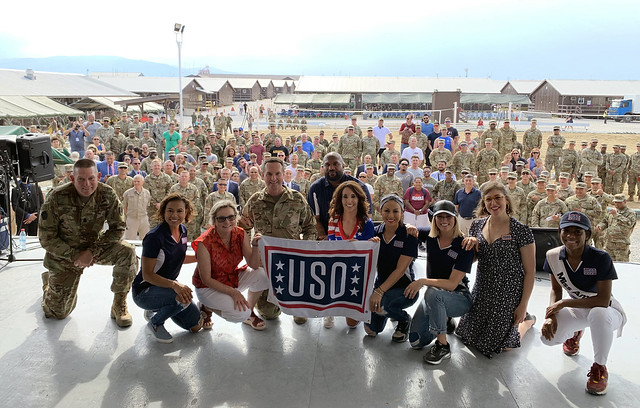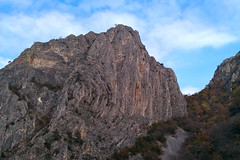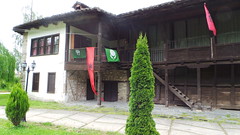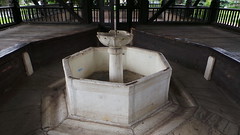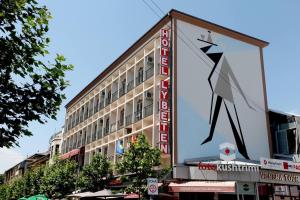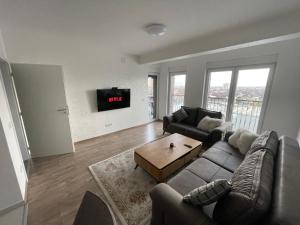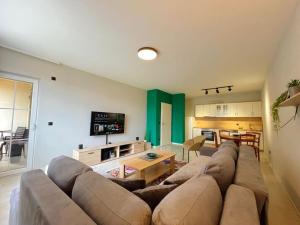Ferizaj
Ferizaj or Uroševac is the sixth largest city in Kosovo by population and seat of Ferizaj Municipality and Ferizaj District.
Ferizaj has been populated since the prehistoric era by the Starčevo, Vinča and Baden culture. During the Ottoman period, Ferizaj served as a trading center on the route between Belgrade and Thessaloniki. Ferizaj has always been considered as a city where tolerance and coexistence in terms of religion and culture has been part of the society in the last centuries. During and after the Kosovo War in 1999, the US Army base Camp Bondsteel was established outside of the city, now being used by forces belonging to KFOR. It is the largest and the most expensive foreign military base built by the Americans in South Eastern Europe, since the Vietnam War.
Ferizaj is located in the south-eastern part of Kosovo, about halfway between the cities of Pristina and Skopje. It is some 230 kilometres north-east of Tirana, 55 kilometres north of Skopje, 300 kilometres west of Sofia, 35 kilometres south of Pristina and 300 kilometres east of Podgorica. Ferizaj is also known for a geographic phenomenon known as river bifurcation. The Nerodime river is divided into two branches and both flow into two different seas. This phenomenon is exclusively seen in nature in this example, and that of the river Casiquiare, Brazil.
History
Early development
The most ancient group of people that inhabited the territory of Kosovo, in the 6th and 5th millenniums BC was the Starčevo culture. Members of this group built homes near rivers and river terraces. They made their homes of willows and mud, while their main profession was plowing and farming. In the next archaeological period, the Vinča culture developed in some parts of Kosovo. These population shifts were made around 4300 BC. The newcomers also built their habitats near rivers. These habitats were unfortified, with dense rows of willows and mud houses. Remnants of their material culture, mostly different forms of ceramic vessels and large numbers of baked clay figures, testify on a higher cultural level.
Following the previously mentioned, Starčevo and Vinča, the Bubanj-Hum culture arrived in Kosovo. This cultural group expanded from the east, from the territory of today's Bulgaria. When carriers of this ethno-cultural group reached the region before the end of the 6th millennium BC, they destroyed Vinča habitats. Remnants of their material culture have not survived.
After Bubanj-Hum, the Baden culture arrived from the Danube, representing its southernmost influence in Kosovo. Baden culture ended before the end of the 3rd millennium BC.
Starting from the 8th century BC and then during the next centuries, until the Roman conquest, can transmit continuously development of a new culture in the region, the Dardanian tribe. The Dardanian burned their dead and bury their remnants in tumuli tombs. In the city, two necropoleis have been found, one in the locality of Kuline near the railway station in Gërlicë, the other in region of Mollopolc, along the Ferizaj-Shtime road.
Around 280 BC some episodes from the life of Dardania reaches historical records as a political community ruled by a king.
Most of the information on the Dardanians is about their wars against the Macedons. The first contact between the Dardania and the Romans came in 200 BC when they offered military assistance in the fight against Macedonia. In 96 BC the Roman Emperor Sulla subdued the Dardani. Numerous Roman settlements were established across the valley, on the old lake terraces. These settlements also accompanied a road network; connecting cities such as Ulpiana and Skopje, which was part of the important road connecting Macedonia to Dalmatia, passing across Ferizaj and the gorge of Kaçanik. A part of the road was discovered on the river bed of the Lepenac, one near the village of Doganaj, the other near the village of Reka.
Middle Ages
The town, was named Ferızovık when it was part of the Ottoman Empire, was little more than a village until 1873, when the Belgrade-Thessaloniki railway was opened, passing through the town. During the Austrian-Turkish wars of the late 17th century and the first half of the 18th century, the major ethnic changes occurred and the rapid Islamization from Ottoman Empire began. According to Turkish sources until the construction of the Mitrovica–Skopje railroad was finished there was no evidence found of a city called Feriz-Bey. At the beginning it was called "Tasjon" by surrounding villagers; this came as a result of the French word station mispronounced by the local residents. But, nonetheless, the town gets its name from its first inhabitant, Feriz Shasivari, who was the owner of a hotel-like building in 1873.
The rapid development of the town started with the construction of the railway station, and within a short period of time, the city became home to different inns, warehouses, and permanent markets. Traders of Kosovo from Prizren to Shkodër, which at that time was by caravan, were mainly diverted towards Thessaloniki. Exporting raw materials especially that of cereals went through Ferizaj and through aligned foreign goods turnover came from Thessaloniki and Skopje. This was the reason that Ferizaj for a period of thirty years became a city with about 400 houses and 200 shops. Most of the population worked in crafts and other activities related to trade. During this period, the opening of the colonial shops, craft workshops accelerated the development of the city.
Modern period
When the settlement fell to Serbia during the First Balkan War, the local Albanian population offered determined resistance. According to certain reports, fighting lasted for three days. The Serbian commander then ordered the population to surrender. When the survivors returned, 300–400 men were executed and according to the Catholic Archbishop of Skopje, Lazër Mjeda, only three Muslim Albanians over the age of fifteen were left alive. The destruction of Albanian-populated villages around Ferizovik followed. The massacre of the Albanian population following the entry of the Serbian army was described by Leo Freundlich who recorded contemporary reports in Albania's Golgotha. According to the war correspondent from Rome's Il Messaggero, the town was destroyed and most of its inhabitants were killed. Freundlich estimated the total number of deaths to be 1,200. Numerous reports from the Balkan Wars including the series of articles from then journalist Leon Trotsky recorded state-organized massacres in numerous locations including Ferizaj, Gjakova, Gjilan, Pristina and Prizren with the total number of deaths at around 25,000.
The Treaty of London in 1913 turned Ferizovik into a part of the Kingdom of Serbia, and the name was changed to Uroševac, after Stefan Uroš V of Serbia. This was part of the Serbianisation efforts of the early twentieth century in which inhabited places within Kosovo were named after heroes from Serbian epic poetry.
The beginning of the First World War partly began with Serbia and Montenegro, and because both were involved directly from the beginning of the war, Kosovo was plagued with fighting. In October of 1915, Bulgaria entered the war as an ally of the German empire, and conducted military operations in the Ferizaj area that were part of the main artery connecting Kumanovo and Skopje with Kosovo. The city had served as a stopping point during the Bulgarian penetration of the Kaçanik Gorge. The Serbian resistance ended on the 25th of November, 1915, when it was vanquished by the Bulgarian Army. This was facilitated by Albanians in hopes that the situation would change and the area would be freed. On the 1st of April, 1916, Ferizaj was left to Bulgaria as a station key, but the usage of the railway was also granted to the Austro–Hungarian Empire as the line: Prizren – Ferizaj – Albania.
The early months of the Second World War had a positive impact on the residents of Ferizaj for not realizing the Convention of 1938, which was signed between Yugoslavia and Turkey for the resettlement of Albanians in Turkey, and that included the massive resettlement of the residents of the District of Nerodime. Under this convention, this migration was to be imposed in the period of 1939 until 1944. The attack led by Italy to Albania that it had not been realized. Under the invasion of Albanian territory by Italians and Germans, the Italian troops were deployed in Ferizaj, due to an auxiliary army airport of the Kingdom of Serbia being discovered, which served Italian military aircraft.
In 1941, the Communist Party's leading bodies of Ferizaj implored more residents to join the National Liberation Movement. By the end of this year, previously established groups of illegal arms were conducting business in the city. With the capitulation of Italy, the country was occupied by Germany, and the behavior of the German occupation was more favorable to the Albanian population than that of the Italians. On 11-12 September 1943, 60 Serbs were killed by Albanians in the area of Ferizaj (Uroševac). After the German invasion, the National Liberation Movement was strengthened even further until 1943 when the arrest and deportation of all participants began. This movement eventually resulted in the liberation of the city on 2 December 1944, and later, in the liberation of the country. After the liberation of Ferizaj, two tasks stood afront the National Liberation Movement: release and protect territory, and rebuild the economy of the country.
Later, the city suffered some damages during the 1999 Kosovo War, with some of its Albanian-populated neighborhoods being shelled and burned by the Yugoslav Army. Following the war, the city has seen serious inter-communal unrest, which has resulted in almost all of the Serbians, and other non-Albanian inhabitants, either being expelled or forced to flee. The Serbian churches of St. Nicholas and St. Stephen were destroyed in 1999 in an act of rebel…
Hotels Ferizaj
Looking for places related to Ferizaj?
Those are other destinations to find places related to Ferizaj:
